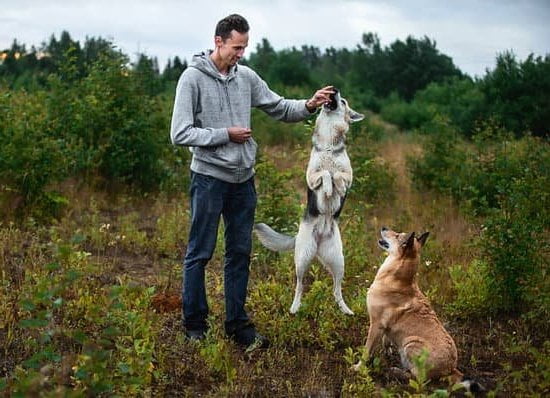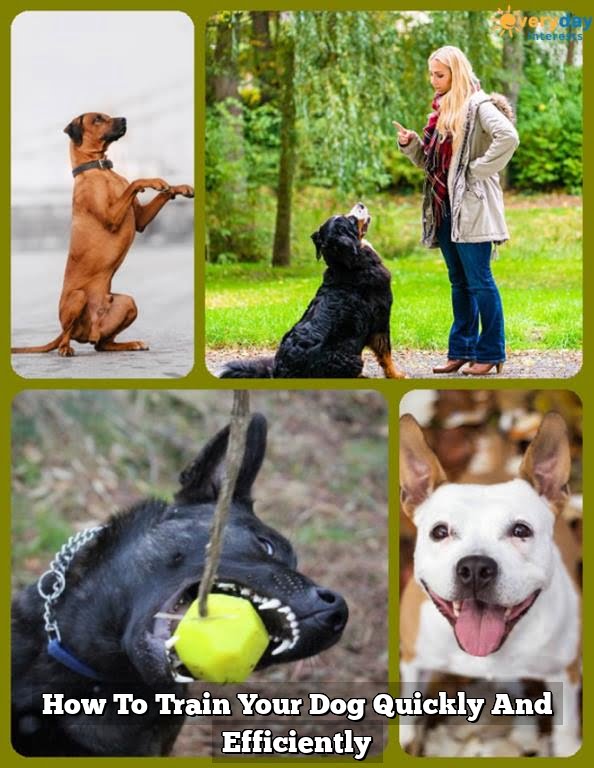Are you wondering how to train your dog quickly? Training your furry friend can be a rewarding and fulfilling experience, but it also requires time, effort, and patience. In this article, we will provide you with the essential tips and techniques for effective dog training. From understanding your dog’s behavior to using positive reinforcement, we will cover all the necessary steps to help you train your dog quickly and efficiently.
Before diving into specific training methods, it’s crucial to understand the basics of dog training. Dogs thrive on routine and structure, so it’s important to establish clear training goals and expectations from the beginning. By setting realistic objectives and being consistent in your approach, you can effectively communicate with your dog and ensure a positive training experience.
In the following sections, we’ll explore various aspects of dog training, including basic commands and techniques, using positive reinforcement, addressing specific behavior problems, and overcoming common training challenges. Whether you’re dealing with a new puppy or an older dog with ingrained habits, our comprehensive guide will provide you with the tools and knowledge needed to train your dog quickly and successfully.
So grab some treats and get ready to embark on an exciting journey of training and bonding with your canine companion.
Understanding Your Dog’s Behavior
Before embarking on training your dog, it is crucial to have a deep understanding of your pet’s behavior. Every dog is different, and their behavior can be influenced by various factors such as breed, age, and past experiences. By being observant and paying close attention to your dog’s body language and reactions, you can gain valuable insights into their personality and tendencies.
One important aspect of understanding your dog’s behavior is recognizing the reasons behind certain actions. For example, if your dog reacts aggressively towards strangers, it could be due to fear or territorial instincts. By identifying the root cause of their behavior, you can tailor your training approach to address the issue effectively.
Moreover, understanding your dog’s behavior also involves acknowledging their natural instincts and drives. Dogs are pack animals with a hierarchy-based social structure. This means that they respond well to clear leadership and structure in their environment. By recognizing and respecting their natural instincts, you can establish a strong foundation for successful training.
In addition to this, understanding how dogs communicate through body language and vocalizations is essential for effective training. This knowledge will help you interpret your dog’s signals accurately and adjust your training techniques accordingly. Ultimately, by understanding your dog’s behavior thoroughly, you will be better equipped to train them quickly and successfully.
Setting Clear Training Goals
Understanding Your Dog’s Needs
Before starting the training process, it’s important to understand your dog’s needs and capabilities. Different breeds may have different behavior patterns, and each individual dog may have its own unique personality. By understanding your dog’s needs, you can set realistic training goals that take into account its energy levels, attention span, and temperament.
Identifying Specific Behaviors to Address
When setting clear training goals for your dog, it’s essential to identify specific behaviors that you want to address. Whether it’s leash pulling, jumping on guests, or excessive barking, pinpointing the problem areas will allow you to focus your training efforts and measure progress more effectively. By setting specific goals for each behavior, you can break down the training process into manageable steps.
Creating a Timeline for Achieving Goals
In order to train your dog quickly and effectively, it’s important to create a timeline for achieving your training goals. Consider factors such as the complexity of the behavior being addressed, the amount of time you can dedicate to training each day, and any upcoming events or changes in routine that may affect the training process. Setting a realistic timeline will help you stay focused and motivated while working towards achieving your training goals.
Basic Commands and Techniques
When it comes to training your dog quickly, mastering basic commands and techniques is essential. These fundamental commands lay the foundation for more advanced training and can help ensure that your dog is well-behaved in various situations.
Some of the basic commands that every dog should learn include sit, stay, come, and down. Training your dog to respond to these commands can make daily activities such as walks, visits to the vet, or interactions with other people and animals much easier and safer.
One of the key techniques for teaching your dog these basic commands is using positive reinforcement. This involves rewarding your dog with treats, praise, or toys when they follow a command correctly. Positive reinforcement creates a positive association with the desired behavior and encourages your dog to repeat it in the future. It is important to be consistent with this technique and use it every time you ask your dog to perform a command.
Consistency and patience are also crucial when teaching basic commands. Dogs thrive on routine, so practicing these commands regularly will help reinforce their understanding of what is expected of them.
Additionally, some dogs may pick up on commands more quickly than others, so it’s important to remain patient and not become frustrated if your dog doesn’t grasp a command right away. By maintaining consistency and patience in your training efforts, you can effectively teach your dog basic commands and set the stage for successful training in other areas as well.
Using Positive Reinforcement
Positive reinforcement is a powerful tool when it comes to training your dog. This involves rewarding your dog for exhibiting the desired behavior, which encourages them to repeat that behavior in the future. When using positive reinforcement, it’s important to choose rewards that are highly motivating for your dog, such as tasty treats, toys, or verbal praise. By consistently rewarding good behavior, you can effectively train your dog and strengthen the bond between you and your pet.
One key aspect of positive reinforcement is timing. It’s crucial to deliver the reward immediately after your dog performs the desired behavior, so they can make a clear connection between their action and the reward. This helps them understand what is expected of them and increases the likelihood of them repeating that behavior in the future. Additionally, vary the rewards to keep your dog engaged and interested in learning.
Incorporating positive reinforcement into your training sessions not only teaches your dog new commands and behaviors but also creates a positive learning experience for them. It’s essential to be patient and consistent with this approach, as it may take time for your dog to fully grasp what is being asked of them. With dedication and positive reinforcement techniques, you can effectively train your dog quickly and enjoy a well-behaved pet.
Consistency and Patience
The Importance of Consistency
Consistency is key when it comes to training your dog quickly and effectively. Dogs thrive on routine, structure, and predictability. This means that in order for your training efforts to be successful, you need to be consistent in your commands, expectations, and rewards. If you use different commands for the same behavior or reward your dog sporadically, it will only confuse them and slow down the training process.
Establishing a Training Schedule
One way to ensure consistency in your training is by establishing a regular training schedule. It’s important to set aside dedicated time each day for training sessions with your dog. By doing so, you can create a routine that your dog will come to expect, making the learning process more efficient. Additionally, having a consistent training schedule will help you stay committed to the process and avoid skipping sessions due to a busy schedule.
The Role of Patience
Patience is another crucial element of successful dog training. Dogs may not learn new behaviors or commands overnight, and some may take longer than others to grasp certain concepts. It’s important to remain patient and understanding throughout the training process, as getting frustrated or impatient with your pet can hinder their progress. Remember that every dog learns at their own pace, and providing them with patience and encouragement will go a long way in achieving positive results.
Addressing Specific Behavior Problems
When it comes to training your dog, it’s important to address specific behavior problems that may be hindering their progress. Understanding what triggers certain behaviors and finding effective ways to address them is crucial in achieving successful training outcomes.
Here are some common behavior problems that you may encounter while training your dog:
- Aggression towards people or other animals
- Barking excessively
- Jumping on people
- Chewing on furniture or belongings
- Seperation anxiety
To address these behavior problems effectively, it’s essential to implement the following strategies:
- Identify the triggers for the specific behavior problem.
- Seek professional help if needed, especially for aggression or severe behavior issues.
- Use positive reinforcement techniques to encourage desirable behaviors.
- Be consistent in addressing the problem and avoid reinforcing negative behaviors inadvertently.
- Patiently work with your dog to modify their behavior gradually over time.
By understanding and addressing specific behavior problems, you can create a more conducive environment for effective training and foster a stronger bond with your furry companion. Remember, every dog is unique, so patience and persistence are key when working through behavior issues.
Tips for Training Success
When it comes to successfully training your dog, there are a few tips that can greatly increase your chances of seeing results. Here are some key tips for training success:
- Be patient and consistent: Training takes time and effort, so it’s important to be patient with your dog. Consistency is also key, as dogs respond well to routine and repetition.
- Use positive reinforcement: Rewarding your dog for good behavior is one of the most effective ways to train them. Whether it’s through treats, praise, or playtime, positive reinforcement can help reinforce desired behaviors.
- Keep training sessions short and frequent: Dogs have shorter attention spans, so keeping training sessions brief but regular can help them stay engaged and focused.
In addition to these tips, it’s important to remember that every dog is unique, so what works for one may not work for another. Understanding your dog’s behavior and tailoring the training approach to their specific needs will also contribute greatly to the success of the training process.
Remember, successful dog training isn’t just about teaching your dog commands – it’s also about building a strong bond with your furry friend based on trust and respect. By following these tips and staying committed to your training goals, you’ll be well on your way to having a well-behaved and happy pup.
Overcoming Training Challenges
Training your dog can be a rewarding experience, but it also comes with its fair share of challenges. Overcoming these challenges is an important part of the training process and requires dedication and patience. One common challenge that many dog owners face is dealing with distractions during training sessions. Whether it’s other animals, people, or simply the environment, distractions can make it difficult for your dog to focus on the task at hand.
To overcome this challenge, start by finding a quiet and familiar environment for training sessions. Minimizing distractions will help your dog stay focused on the commands you are teaching. As your dog becomes more proficient in their training, gradually introduce more distractions to test their abilities and reinforce their training in various environments.
Another common challenge is dealing with stubborn behavior from your dog. Dogs are individuals with their own personalities, and some may be more resistant to training than others. When faced with stubborn behavior, it’s important to remain calm and patient. Consistency is key when addressing this challenge – continue practicing the same commands and techniques until they become second nature to your dog.
Finally, many dog owners struggle with maintaining motivation throughout the training process. It’s important to remember that progress takes time, and there will be setbacks along the way. Celebrate small victories and be patient with yourself and your dog as you work through challenges together.
Seek out support from other dog owners or consider enlisting the help of a professional trainer if you feel overwhelmed by the process. With dedication and perseverance, you can overcome training challenges and help your dog reach their full potential.
Conclusion and Next Steps for Ongoing Training
In conclusion, training your dog quickly and effectively requires an understanding of their behavior, setting clear goals, using positive reinforcement, and being consistent and patient. By implementing the basic commands and techniques outlined in this article, you can lay a strong foundation for ongoing training.
Remember that addressing specific behavior problems may require extra time and patience. It’s important to approach these challenges with a calm and positive mindset, utilizing the tips for training success provided in this article. Whether it’s leash pulling, excessive barking, or separation anxiety, with the right approach and dedication, you can overcome these obstacles.
As you continue your journey in training your dog, always keep in mind that every dog is unique and may respond differently to various techniques. Stay open to learning new methods and adapting your training style as needed. Celebrate small victories along the way and seek professional help if necessary.
Ongoing training is essential to maintain good behavior and strengthen the bond between you and your furry companion. With dedication and love, you can achieve great success in training your dog quickly and effectively.
Frequently Asked Questions
What Are the 5 Golden Rules of Dog Training?
The 5 Golden Rules of Dog Training are consistency, positive reinforcement, patience, proper timing, and setting realistic expectations. Consistently enforcing rules and commands, using rewards like treats or praise for good behavior, remaining patient during the training process, timing corrections or rewards appropriately, and understanding that training takes time and effort are all essential components to successfully train a dog.
How Long Does It Really Take to Train a Dog?
The time it takes to train a dog varies depending on several factors such as the dog’s breed, age, temperament, and previous training experience. However, in general, basic obedience training can take a few weeks to a few months for a dog to fully grasp commands and behaviors.
Advanced training or addressing specific behavioral issues may take longer. It’s important for owners to maintain consistency and practice regularly to achieve positive results in training.
How Do You Train a Dog 5 Minutes a Day?
Training a dog for just 5 minutes a day can be an effective way to improve obedience and behavior over time. By incorporating short training sessions into daily routines, owners provide consistent reinforcement that can lead to lasting results.
Focusing on one specific command or behavior during each session helps keep the training sessions engaging and productive for the dog. Even with just 5 minutes a day, the cumulative impact of regular training can make a significant difference in shaping a well-behaved canine companion.

Welcome to the blog! I am a professional dog trainer and have been working with dogs for many years. In this blog, I will be discussing various topics related to dog training, including tips, tricks, and advice. I hope you find this information helpful and informative. Thanks for reading!





